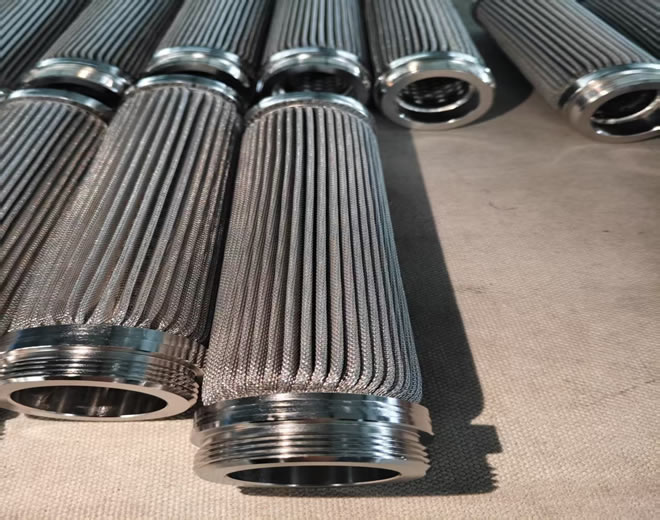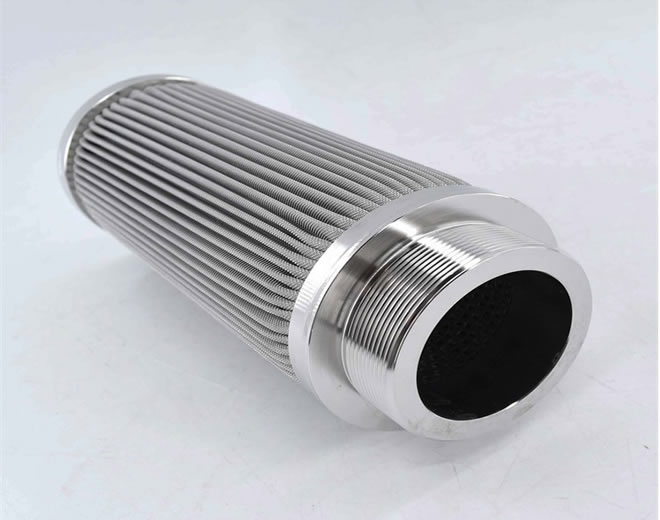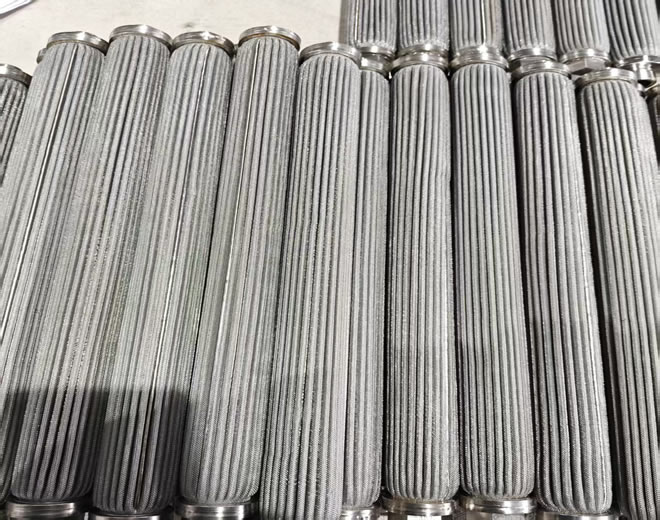









The use of Stainless Steel Sintered Fiber Pleated Filter Cartridges is a critical and specialized technology for ensuring quality and efficiency in the production of recycled plastics.
This is a high-performance filter element designed for high-temperature, high-pressure, and high-precision filtration applications. Let's break down the name:
Stainless Steel: Refers to the material of construction, typically high-grade stainless steels like 304, 316, or 316L. This provides exceptional mechanical strength, corrosion resistance, and high-temperature tolerance (withstanding over 500°C), making it ideal for the harsh environment of molten recycled plastic.
Sintered Fiber: Describes the filter media. Multiple layers of non-woven stainless steel fiber wool are laid down and sintered together in a high-temperature vacuum furnace. This structure creates:
High Porosity: Low flow resistance and high dirt-holding capacity.
Depth Filtration: Contaminants are trapped within the three-dimensional matrix of the media, not just on the surface, leading to a longer service life.
Stable Structure: Provides consistent and reliable filtration accuracy, preventing "media migration" or "bypass."
Pleated: Refers to the physical form. The flat sintered fiber sheet is folded into a pleated (like an accordion) pattern. This significantly increases the effective filtration area—often 3 to 5 times that of a plain surface filter—allowing for high flow rates and longer cycles between changes.
Filter Cartridge: The final product form, typically with metal end caps and a central core, ensuring structural integrity under pressure.
In summary: It is a core component that uses pleated, multi-layered sintered stainless steel fibers to achieve high-flow, high-precision, and long-life depth filtration in a compact space.
Recycled plastics (e.g., rPET, rPP, rPE) come from complex waste streams and contain a significant amount of contaminants that can severely damage equipment and final product quality. The primary functions of this cartridge are:
Removing Solid Contaminants:
Macro-contaminants: Such as paper, labels, metal fragments, glass, and sand.
Micro-contaminants: Such as carbonized particles (from thermal degradation), gel particles, and unmelted plastic flakes.
Protecting Downstream Equipment:
Prevents wear and seizure of the melt pump.
Prevents clogging of the die head and spinnerets, reducing downtime for cleaning and increasing overall production efficiency.
Enhancing Final Product Quality:
Improves Purity: Filtered melt is cleaner, resulting in better clarity and mechanical properties (strength, toughness) of the final pellets or products.
Reduces Defects: In applications like fiber spinning or film extrusion, it effectively eliminates defects like "fiber break," "gel dots," and "fish eyes" caused by impurities.
Adds Value: High-quality recycled plastic can enter premium application markets (e.g., food-contact packaging, automotive parts), commanding higher prices.
High Filtration Precision: Typically available from 1 μm to 150 μm, selectable based on the cleanliness of the feed material and the required product specifications.
Large Dirt Holding Capacity: The depth filtration structure and pleated design allow it to hold a large amount of contaminant, extending service life.
Excellent Thermal Resistance & Thermal Shock Resistance: Can withstand the high temperature of the polymer melt (typically 200-300°C) and the pressure surges from the melt pump.
High Strength & Stability: Resists deformation and bursting under high differential pressure, preventing "bypass" failure.
Superior Chemical Compatibility: Resistant to corrosion from polymer melts and various additives/processing aids.
Cleanable & Reusable: These precision cartridges are often a capital investment. They can be cleaned via ultrasonic cleaning, thermal baking (burn-off), or chemical soaking to remove contaminants, allowing for multiple reuses and reducing long-term operating costs.
When selecting and using these filter cartridges, consider the following key factors:
Filtration Rating: Higher is not always better. An excessively fine rating will shorten service life and increase cost, while a rating that is too coarse will not provide adequate purification. Balance is needed based on feedstock contamination and product requirements.
Material Grade:
316L Stainless Steel: The most common and recommended choice for most recycled plastics due to its superior resistance to chloride corrosion.
304 Stainless Steel: A cost-effective option for less corrosive environments.
Special Alloys (e.g., Hastelloy): For processing plastics with highly corrosive additives or decomposition products.
Dimensions: Must be compatible with your screen changer (continuous or discontinuous) model.
Differential Pressure (ΔP) Monitoring: Install pressure gauges upstream and downstream of the filter. The pressure drop across the cartridge will increase as contaminants accumulate. When it reaches a pre-set maximum limit (dictated by production needs), the cartridge must be replaced or cleaned.
Cleaning and Service Life:
Cleaning efficiency will gradually decrease with each cycle.
Monitor the initial clean ΔP and service life after each cleaning. A significant increase in initial ΔP or a sharp drop in service life indicates the cartridge is at the end of its useful life and should be replaced.